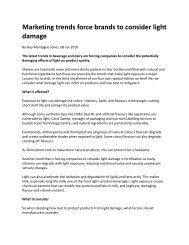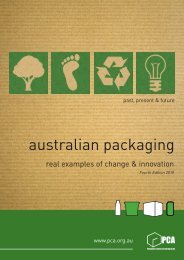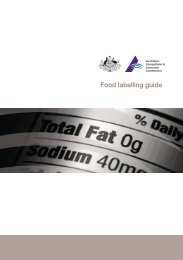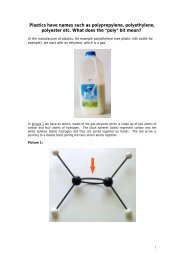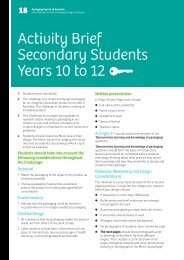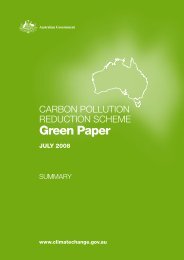Environmental Code of Practice for Packaging - the Packaging ...
Environmental Code of Practice for Packaging - the Packaging ...
Environmental Code of Practice for Packaging - the Packaging ...
Create successful ePaper yourself
Turn your PDF publications into a flip-book with our unique Google optimized e-Paper software.
5.3 Recovery and Recycling<strong>Packaging</strong> should be designed and produced in such a way as to maximise its potential <strong>for</strong> recovery andrecycling at end-<strong>of</strong>-life and to minimise <strong>the</strong> environmental impacts <strong>of</strong> its disposal.The packaging design should support recovery in accordance with <strong>the</strong> waste hierarchy, with preferencegiven to recycling <strong>for</strong> <strong>the</strong> same or similar application (‘closed loop’) followed by recycling <strong>for</strong> analternative application (‘downcycling’ or composting).Where possible, <strong>the</strong> package should consist <strong>of</strong> a single material, or materials, which can be readilyseparated and sorted <strong>for</strong> recovery. <strong>Packaging</strong> should be designed to minimise <strong>the</strong> impacts that anycomponents such as closures, labels, sleeves, carry handles, etc may have on <strong>the</strong> recovery process. Thisrequires consultation with companies involved in collection, sorting and reprocessing <strong>of</strong> <strong>the</strong> packaging.<strong>Packaging</strong> (including imported packaging and packaged goods) must not be introduced into <strong>the</strong> marketwithout full consideration <strong>of</strong> <strong>the</strong> impacts on resource recovery and recycling, <strong>for</strong> example degradableplastics packaging. However users <strong>of</strong> <strong>the</strong> <strong>Code</strong> and Guidelines should recognise that innovation leadingto improvements in long term environmental outcomes should also be encouraged and consideredwhere appropriate (even if <strong>the</strong>re are short term or transitional difficulties).Refer to Section 12 <strong>of</strong> <strong>the</strong> Guidelines and to <strong>the</strong> Recycling Materials Manual available from <strong>the</strong>Australian Council <strong>of</strong> Recyclers.5.4 Ability to Incorporate Recycled Content<strong>Packaging</strong> should maximise <strong>the</strong> use <strong>of</strong> recycled content where use <strong>of</strong> such content is physicallypossible, not detrimental to <strong>the</strong> function <strong>of</strong> <strong>the</strong> packaging or <strong>the</strong> packaged product, and would notviolate applicable health and safety standards.Priority should be given to incorporating post-consumer recycled material to support markets <strong>for</strong>material collected from recovery systems. Where appropriate, post-industrial recycled material shouldalso be incorporated and considered.In accordance with AS/NZS ISO14021, where a claim <strong>of</strong> recycled content is made, <strong>the</strong> percentage <strong>of</strong>pre-consumer or post-consumer recycled material shall be stated.Refer to Section 13 <strong>of</strong> <strong>the</strong> Guidelines.5.5 Minimising Impacts <strong>of</strong> <strong>Packaging</strong>Users <strong>of</strong> <strong>the</strong> <strong>Code</strong> and Guidelines should consider <strong>the</strong>ir common law liabilities in relation to <strong>the</strong> use <strong>of</strong>hazardous or toxic materials, assess <strong>the</strong> packaging <strong>for</strong> <strong>the</strong> presence <strong>of</strong> toxic substances that are likely topose risk and endeavour to reduce that risk accordingly.Refer to Section 14 <strong>of</strong> <strong>the</strong> Guidelines.FINAL DOCUMENT 25 MAY 2005 - 6 -




